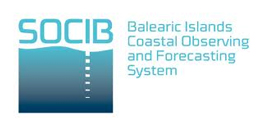Infrastructure
(short name)
Balearic Islands Coastal Observing and Forecasting System
(SOCIB)
Installation
(short name)
SOCIB glider facility
(SOCIB-GF)
Location
Mallorca, Balearic Islands, Spain, Mediterranean Sea

Coordinates/Routes
39.6665°N - 2.5809°E
Bottom depth
Legal name of organisation
Balearic Islands Coastal Ocean Observing and Forecasting System (SOCIB)
Country
Spain
The SOCIB Glider Facility (SOCIB-GF) is a key component of SOCIB, a marine research infrastructure that implements and brings state-of-the-art multi-platform systems and technology to monitor and sustain high-resolution observations in coastal and open ocean regions. Glider activities in the Balearic Sea started in 2006 under IMEDEA projects, and the SOCIB-GF has been fully active since 2012, with an important contribution during the JERICO-NEXT project (2015-2019) and JERICO-S3 (2019-2023). It has accomplished more than 130 missions, including 3.600 days in water, 40.000 nm navigated, and 137.000 vertical profiles collected. The SOCIB-GF team is composed of 3 full-time glider technicians, 2 part-time field technicians (for sea operations), 2 part-time data engineers (for glider data management), 1 part-time TA access scientist, and 1 part-time experienced scientist. An intense and fruitful collaboration with the IMEDEA (CSIC-UIB) team has also been established since the origin of glider operations.
The fleet in 2022 consists of 3 Slocum gliders (2 G2 and 3 G3 versions) and 2 iRobot Seagliders (2 KA), equipped with a suite of sensors able to collect both physical (temperature and conductivity) and biogeochemical observations (chlorophyll fluorescence, oxygen, CDOM, PAR, backscatter at 700 nm and turbidity) at high spatial resolutions (~ 2 km). The SOCIB-GF installations include a pressure chamber (1000 m), a ballasting tank as well as a lab and office space. It also has access to other SOCIB facilities such as 1) ETD (Engineering and Technology Development), 2) Data Center (including data management, public repository, online web-based platform tracker -for mission monitoring- and development of tools such as the glider processing toolbox (Troupin et al., Methods in Oceanog., 2015, – freely available scripts available at GitHub – socib/glider_toolbox: MATLAB/Octave scripts to manage data collected by a glider fleet, including data download, data processing and product and figure generation, both in real-time and delayed time), and 3) a harbour warehouse. Besides, the SOCIB-GF uses for the glider deployments and recoveries 2 research vessels: 1) Hurricane Zodiac 9.2 m RIB and 2) SOCIB-R/V, a 24 m coastal catamaran.
More information about SOCIB, the SOCIB-GF, glider missions, and observations can be found at:
- http://www.socib.eu/ (main)
- http://www.socib.eu/?seccion=observingFacilities&facility=glider
- http://www.socib.eu/?seccion=multimedia
- http://apps.socib.es/dapp/ (on-line mission tracker)
- http://thredds.socib.es/thredds/catalog/auv/glider/catalog.html (glider data public repository)
The ocean gliders have been equipped with a suit of sensors as listed in the the table below:
|
Sampling1: max. freq. This param. is configurable.
Real time subset data recovery2: This param. is configurable. Full dataset at end of the mission.
Typical sensors, sampling rates and surfacing times -when data are transmitted – are:
The SOCIB gliders are configured with a default sampling strategy defined to balance efficient and cost-effective scientific-data collection, near real-time transmission (NRT Tx), and quality control. That is an adjustable decimation of 60 to 120 seconds:
– CTD: f SAMPLING =1/4 Hz ; depth-range=[full water column]
– OXY: f SAMPLING =1/4Hz ; depth-range=[full water column]
– FLNTU: 2 strategies:
o f SAMPLING =1/8Hz ; depth-range=[0- 150m]
o f SAMPLING =1/16Hz ; depth-range=[150- 300m]
– ECO triplet: 2 strategies:
o f SAMPLING =1/8Hz ; depth-range=[0- 150m]
o f SAMPLING =1/16Hz ; depth-range=[150- 300m]
– PAR: f SAMPLING =1/8Hz ; depth-range=[0- 300m]
Similarly, the SOCIB communication surface strategy is the following:
– Surface when Waypoints are reached (NRT Tx.)
– Surface for periodical report at UTC 4am, 12am, and 20pm (NRT Tx.)
Finally, the standard NRT Tx strategy, concerning the science data only, implies the transmission of the first physical (CTD) and biogeochemical (Oxygen, Chlorophyll fluorescence, FDOM fluorescence, Turbidity and backscatter at 700 nm) profile (with decimation) stored after the previous surface. This approach is only indicative of the SOCIB glider endurance-line between Mallorca Island and Denia. The proposed strategies depend on the nature of the mission and the user’s needs.
● Remote: The SOCIB-GF prepares and pilots the gliders. The SOCIB-GF team also checks the real-time observations, so the user presence is not required.
● Partially remote: the presence of the user group is required to some extent e.g., installing and uninstalling the user’s additional equipment.
● In person/hands-on: the presence of the user group is required/recommended during the whole glider operation period in one the above stages.
Unit of access (UA): ocean glider / day.
SOCIB provides access to one or more ocean gliders for autonomous operation at sea. Access to the SOCIB glider fleet by a user group is treated as a concession granted to use the infrastructure, one or several ocean gliders, prior contact to SOCIB required to assure piloting and operation capabilities. A dedicated experiment should be defined between the user group and SOCIB to collect physical and/or biogeochemical observations.
The SOCIB glider team will support the potential users at any stage in proposal development. SOCIB will provide access to a number of specific complementary services:
1) preparation and operation of ocean gliders with the highest international standards;
2) qualified personnel for the management of the ocean gliders (platforms and sensors), including logistics for deployment and recovery;
3) a 24/7 operational system to pilot the gliders at sea;
4) access to a collaborative piloting system;
5) access to a collaborative Data Management system;
6) quasi real-time (usually less than 8 hours) reception of data and visualization system;
7) a SOCIB standard post mission glider report;
8) near real-time and delayed-time data in Netcdf format.
9) access to a scientific analysis collaborative team.
Special rules
All proposals will undergo peer-review regarding the study area, feasibility, mission definition and scientific objectives.
All proposals will undergo careful peer-review regarding study area, feasibility, mission definition, benefits
